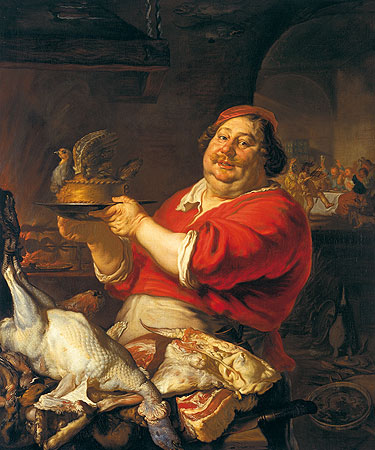Main information:
Schleißheim New Palace
Gallery rooms / German Baroque Art (Rooms 30-33)
The northern ground-floor apartment was used by Electors Karl Albrecht and Max III Joseph. The ceremonial sequence of rooms consisting of the Antechamber, Audience Room, Bedroom and Large Cabinet (Rooms 30-33), with the adjoining smaller cabinets, the Stucco-work Cabinet and the Carpentry Room, corresponded to the apartments on the upper floor. In the second half of the 18th century, Max III Joseph had the walls covered with light-blue brocatelle or damask, so that it then became known as the "Blue Apartment". The present wall coverings were renewed based on baroque models in 1976.
State Gallery of European Baroque Art – German Art

February from the series of month pictures,
Joachim von Sandrart, 1642/43
(Room 31)
Around 40 17th-century German works are displayed in Rooms 30-33. With the decades of havoc and devastation caused by the Thirty Years' War, German art was unable to develop in the same way as that of Flanders and Italy, and no leading baroque painting school emerged. The works shown in Schleißheim, however, testify to the fact that paintings of outstanding quality were nevertheless produced by German masters in the 17th century.
The cosmopolitan painter and important art writer Joachim von Sandrart occupies a special position here, as his famous "Cycle of twelve months" dating from 1642/43 was commissioned by the Bavarian elector Maximilian I specifically for the Old Palace of Schleißheim (Room 31).
Johann Carl Loth, who lived in Venice, was also famous throughout Europe. His works are shown here together with those of his father Johann Ulrich Loth, who was an important representative of Munich art in the mid-17th century (Room 32). Johann Heinrich Schönfeld and Johann Heiss are represented with characteristic works as the two main masters of the Augsburg School, the leading German school in the second half of the century, and there are several outstanding paintings by Johann Heinrich Roos, who worked mainly in Frankfurt and was already famous in the 18th century as the "Rafael of animal painters" (Room 33).
© Text and picture State Gallery: Bayerische Staatsgemäldesammlungen, Munich
State Galleries in Bavaria (Website of the Bayerische Staatsgemäldesammlungen)


Recommendation in the social media
Facebook Twitter Google Plus